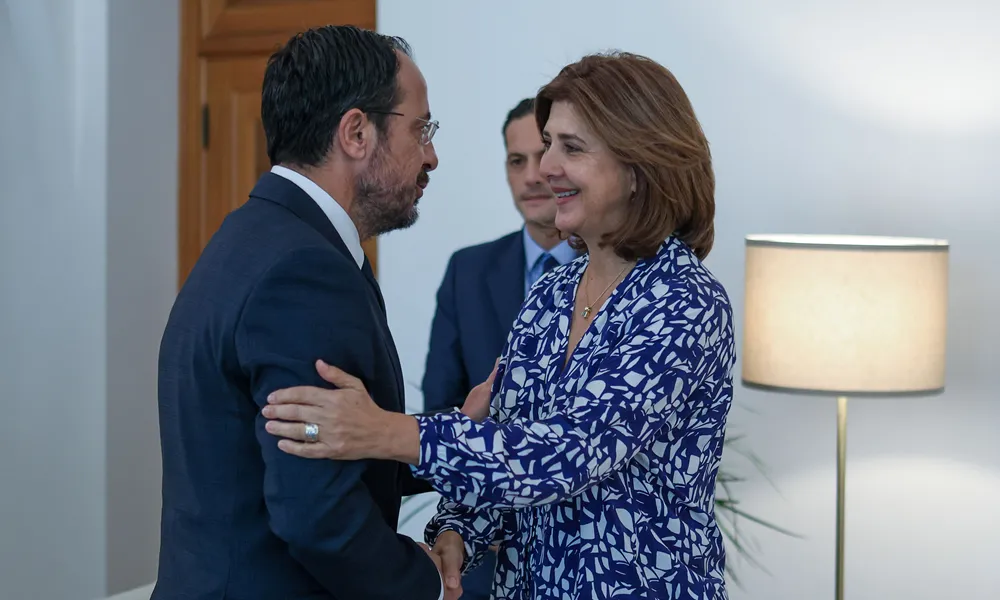It’s up to the two leaders to take decisions on confidence-building measures (CBMs), said UN envoy María Ángela Holguín on Friday after meeting with President Nikos Christodoulides in Nicosia.
Holguín said her visit aims to prepare the ground for a meeting in September between UN Secretary-General António Guterres and the two Cypriot leaders.
The SG’s personal envoy told reporters that she came to the island to see the “whole picture” of how things are, and to get a sense of the “ambiance” before reporting back to the SG ahead of the trilateral meeting between the UN chief and the two Cypriot leaders in New York.
Asked about the prospects of implementing confidence-building measures (CBMs) in the current political climate, Holguín stressed that ultimate responsibility lies with the Cypriot leaders.
“The UN and myself and the SG, we are doing all our best, but the leaders have to take decisions,” she said.
According to government spokesperson Konstantinos Letymbiotis, the meeting between Guterres and the two leaders will likely take place on September 27 in New York.
The president repeated his determination in the meeting to contribute in every possible way to the SG’s efforts to resume negotiations from where they left off, based always on UN Security Council resolutions, said Letymbiotis.
Asked if there was progress on CBMs, the spokesperson said progress had been achieved on some of the issues, but not enough.
Next steps
Following the trilateral in New York this month, and the Turkish Cypriot leadership elections in October, a third informal meeting of the two leaders and three guarantor powers is expected to take place later this year under UN auspices.
The aim will be to follow up on initiatives agreed by the parties in the previous expanded format, including the opening of crossing points and a solar energy installation in the buffer zone.
Meanwhile, Holguín will meet with civil society during her stay, including sharing refreshments and a chat with the Buyuk Han Bicommunal Coffee Club on Saturday. On Monday, the personal envoy will meet with Turkish Cypriot leader Ersin Tatar, and with members of the Committee on Missing Persons.
Her itinerary includes a meeting with Greek Cypriot negotiator Menelaos Menelaou, visits to cemeteries that have been restored on both sides, a meeting with the newly established bicommunal Technical Committee on Youth, and contacts with representatives of the Chambers of Commerce. Holguín is expected to conclude her visit on Tuesday.
Longest period without talks
Negotiations on the Cyprus problem have not been held since 2017, marking eight years since an international summit in Crans-Montana aimed at reaching a breakthrough collapsed.
This is the longest period without substantive negotiations on the conflict since the island’s comprehensive division in 1974.
Three years after the Turkish invasion, the first High-Level Agreement between the leaders of the two communities was reached in 1977, followed by a second, expanded High-Level Agreement in 1979.
In 1986, following consultations with the two leaders in the two years prior, the then UN SG Javier Pérez de Cuéllar proposed a Draft Framework Agreement which envisaged the creation of an independent, non-aligned, bicommunal state in Cyprus, which included the concept of a “bizonal” state.
De Cuéllar’s successor Boutros Boutros-Ghali worked with the leaders on a new "Set of Ideas" for an overall framework agreement in 1992, further expanding on previous concepts while proposing a secular, bizonal, bicommunal federal republic composed of two politically equal communities.
The two leaders followed up on the Set of Ideas with talks on a package of CBMs that led to an agreement “in principle” in 1994.
At this point, the European Union becomes a major factor in the talks, leading to intense discussions on a package deal that would include a customs union with Turkey, accession negotiations for Cyprus, and later EU candidate status for Turkey.
Proximity talks between the two sides in Cyprus were launched in 1999 followed by direct negotiations in 2002, culminating in the Annan Plan referendum in 2004.
The next major milestone was the Gambari Principles in 2006 in which the two leaders signed a set of principles and decisions, including the notion of establishing technical committees on issues affecting the day-to-day lives of people.
Formal negotiations began again in 2008 until 2012.
The next and final phase of peace talks began in 2014 with a Joint Declaration between Nicos Anastasiades and Dervış Eroglu, followed by talks between the former and Mustafa Akinci in 2015, ending in the Swiss resort of Crans-Montana in 2017.
Since then, leaders of the two communities have met informally and in an expanded format with representatives of the three guarantor powers to discuss low-level issues, such as CBMs. However, for the last eight years, there has been no formal process and no agreement on what the basis of any negotiations would be.
For a documented history of the peace talks in English, see here.
